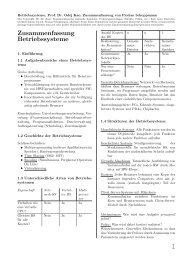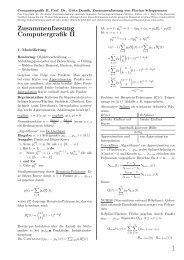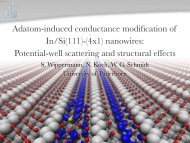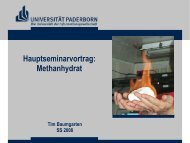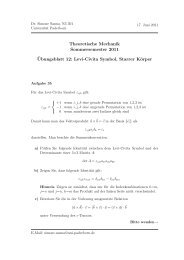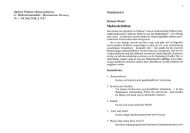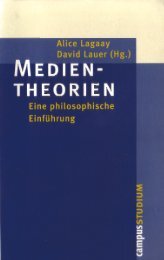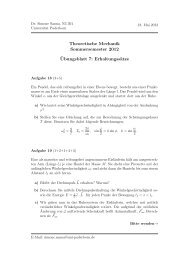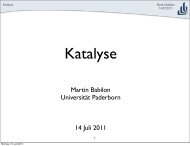Skript / lecture notes - Universität Paderborn
Skript / lecture notes - Universität Paderborn
Skript / lecture notes - Universität Paderborn
Erfolgreiche ePaper selbst erstellen
Machen Sie aus Ihren PDF Publikationen ein blätterbares Flipbook mit unserer einzigartigen Google optimierten e-Paper Software.
Prof. Dr. Wolf Gero Schmidt<br />
<strong>Universität</strong> <strong>Paderborn</strong>, Lehrstuhl für Theoretische Physik<br />
Damit erhalten (unter Beachtung der Einstein Konvention) die Standardform der Altogether<br />
we thus obtain (observing the Einstein convention) the standard form of the<br />
Dirac–Gleichung Dirac equation<br />
(<br />
)<br />
i γ k ∂ k − mc ψ = 0 (5.46)<br />
Jede Komponente von ψ genügt (nach Konstruktion der Dirac–Gleichung) der Klein–<br />
Gordon–Gleichung. Die Umkehrung gilt aber nicht, vielmehr stellt die Dirac–Gleichung<br />
Abhängigkeiten zwischen den Lösungen der Klein–Gordon–Gleichung her. All the components<br />
of the wave function ψ individually satisfy the relativistic energy–momentum<br />
relation, i.e., the Klein-Gordon equation. However, not all solutions of the Klein-Gordon<br />
equation are as well solutions to Dirac equation, because the latter asserts additional<br />
constraints on the individual components.<br />
Bem Note: Analogie zur Elektrodynamik: Wellengleichungen für ⃗ E und ⃗ B–Feld, aber<br />
diese Felder werden zusätzlich durch die grundlegenderen Maxwell–Gleichung verknüpft.<br />
The above situation is similar to electrodynamics, where wave equations<br />
hold for the electric and magnetic fields individually, but they are additionally<br />
related by Maxwells equations.<br />
Energie–Impuls–Relation energy-momentum relation<br />
Nach de Broglie wird ein freies Teilchen der Energie E und mit Impuls ⃗p durch eine Welle<br />
According to the concept of matter waves or de Broglie waves a free particle of energy E<br />
and momentum p may be represented by wave function<br />
repräsentiert (QM I).<br />
ψ = A · e i (⃗p·⃗r−Et) (5.47)<br />
Setzen ψ jetzt in die Klein–Gordon–Gleichung ein Insert ψ in the Klein–Gordon equation<br />
{( 1 ∂ 2 )<br />
c 2 ∂t 2 − ∇ ⃗ 2 + m2 c 2 }<br />
2 Ae i (⃗p·⃗r−Et) = 0 (5.48)<br />
{− E2<br />
c 2 2 + ⃗p 2<br />
2 + m2 c 2 }<br />
2 Ae i (⃗p·⃗r−Et) = 0 (5.49)<br />
für A ≠ 0 folgt for A ≠ 0 it holds<br />
E 2 = c 2 ⃗p 2 + m 2 c 4 (5.50)<br />
D.h. Klein–Gordon–Gleichung (und damit auch Dirac–Gleichung) führen zur relativistischen<br />
Energie–Impulsbeziehung Obviously both the KGE and the DE comply with the<br />
relativistic energy-momentum relation<br />
73




